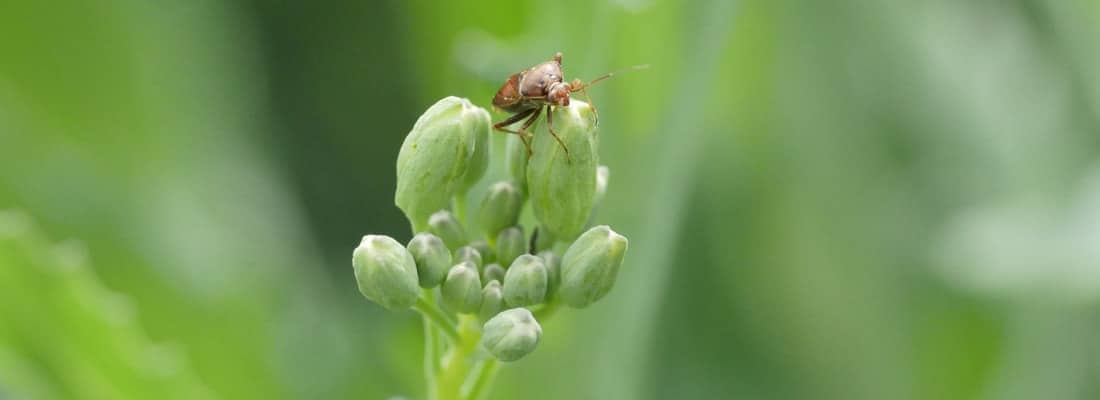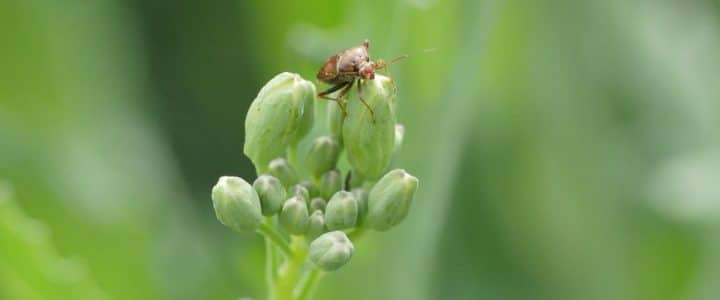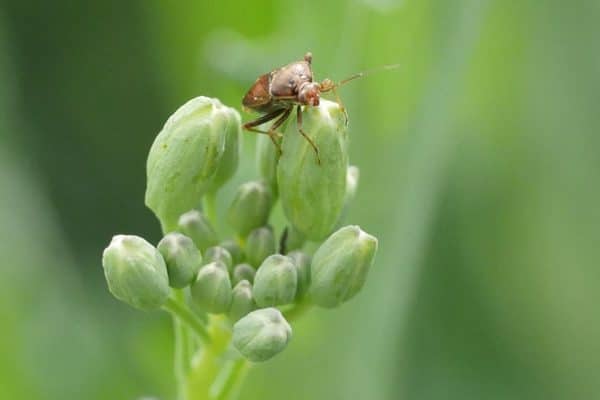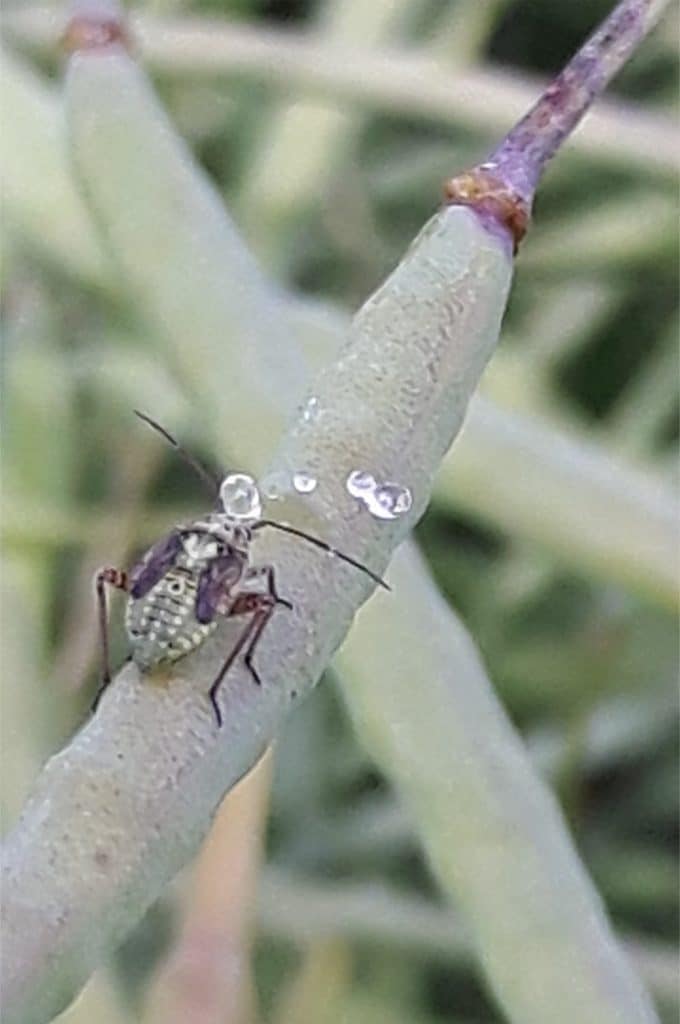A common pest in canola (and can be an issue in other crops), the lygus bug has piercing-sucking mouthparts which cause physical damage to the plant through their nymphThe juvenile or immature stage (ex. of an insect) which goes through incomplete metamorphosis. More and adult stage by puncturing the tissue and sucking plant juices. There are economic thresholds to consider before potential insecticide applications for lygus bugs.
Important tips for best management
- Scout for lygus bugs under fair weather conditions (ex. sunny, low wind, above 15°C) and typically aiming between 10:00- 16:00) when the crop is at the bolting through late pod stages.
- Using a sweep net to collect samples and consult the economic thresholdAn economic threshold is the level of infestation (ex. pest insect density) at which lost yield (ex. due to feeding/insect pest damage) exceeds the cost of the chemical and its application. More charts, which consider application costs, canola prices, and plant development stage (end of flowering versus pod ripening) in determining the need for insecticidal control. Economic thresholds also help conserve and protect natural enemies
- The oldest (fourth and fifth instarA developmental stage within one life stage (ex. of an insect) More) nymphs and adult lygus bugs are responsible for most of the feeding injury.
- Scout and manage cabbage seedpod weevil and lygus bug separately (and ensure to not confuse lygus bugs with alfalfa plant bugs).
- Learn t
- Check out Canola Watch’s ‘Lygus bugs’ summary article and find canola production-related lygus research on the Canola Research Hub.
Overview of the lygus bug
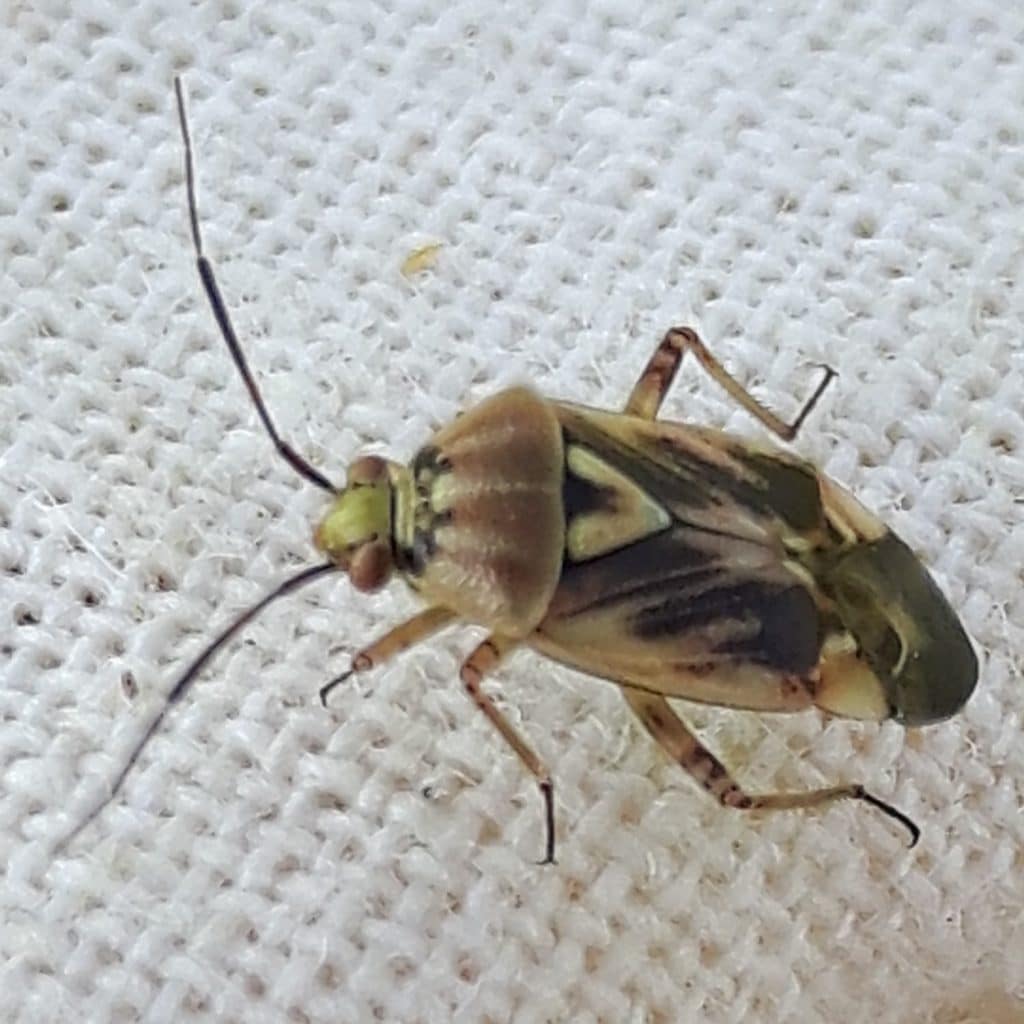
Lygus bugs refer to members of the genus Lygus within the plant bug family (Miridae). They are small, oval-shaped insects that feed on a range of crops and weeds. At least as many as four Lygus species are found on the Canadian prairies. They feed on the sap of new growth and reproductive tissues of plants. Host plants can include alfalfa, canola, lentils, potato, strawberries, vegetable crops, flax, hemp, faba bean, tree fruits, and weeds such as redroot pigweed, stinkweed, wild mustard and lamb’s-quarters. Lygus bugs are important pests of canola with both adult and nymphThe juvenile or immature stage (ex. of an insect) which goes through incomplete metamorphosis. More (juvenile) stages causing economic damage 1,2,3,4 that can reach levels where insecticidal control is necessary.
Background
Lygus bugs are always present in canola fields because they are native to the area. Yet widespread outbreaks (high populations) causing economic levels of damage are not common. In 1996, the first time canola was treated for a lygus bug infestation, about 4,000 hectares (10,000 acres) were sprayed in the Vulcan, Alberta area. In 1997, lygus bugs damaged canola in the Foothills, Newell, Vulcan, Willow Creek, Bonnyville and Peace River regions of Alberta and in the Meadow Lake area of Saskatchewan. Insecticide was applied to about 162,000 hectares (400,000 acres) for lygus bug control that year, yet crop damage was estimated to have exceeded $10 million. In 1998, more than 1,400,000 acres were sprayed to control lygus bugs in Alberta. Since then outbreaks tended to be isolated (ex. the Peace River region and isolated fields in south central Alberta in 2010), until 2012 when high populations were reported over a wider geographic area, including a large portion of Alberta and some fields Saskatchewan and Manitoba. Historically low populations of lygus bugs have generally been reported in western Canada from 2016 to 2019. Lygus have been reported in much higher numbers across this same region in 2021 5.
Life cycle of the lygus bug
Each year may consist of one to three generations of lygus bugs, depending on the geographical region of the Prairies 6,7. For example:
- One generation in northern regions.
- Two generations in southern regions.
- Three generations in southern Manitoba.
In all regions, an extra generation is possible in years when an early spring and late fall occur. This is because lygus bugs emerge early in the spring, feed and begin to reproduce on early season host plants. This means an additional generation that can attack canola at bolting is possible.
Lygus bugs overwinter as adults by finding shelter under plant litter in shelterbelts, headlands, uncultivated areas and field margins. Field experiments conducted in southern and northern Alberta showed that in these insulated areas, temperatures can remain above minus five degrees Celsius, although air temperatures can dip below -30 degrees Celsius 8. Lygus bugs are sufficiently cold hardy and do not experience significant mortality until temperatures drop below -10 degrees Celsius 9. In northern Alberta, overwintered adults emerge in the early spring (e.g. early May) to seek out early growing vegetation such as budding willows, and then move onto rapidly growing winter annual weeds, such as stinkweed or flixweed. Overwintering adults can also be abundant in volunteer canola and early-seeded (spring) canola, especially if these crops are in budding or flower stage while other hosts are not yet available. After mating (in May through early July) females seek suitable host plants, such as budding alfalfa or canola, to lay their eggs on. Eggs are laid individually into the stems and leaves of host plants. The first nymphs appear around the end of May. In the south, the new generation adults first appear around the end of June. Nymphs (first to fifth instars) can emerge and develop on these earlier season weed hosts, but usually adults relocate to, or even emerge from overwintering in, alfalfa and clovers in mid-spring.
Once canola is at bolting to early flowering stages, lygus adults start to appear and, by mid-flowering, high numbers of lygus adults and nymphs can be present, with densities typically peaking during late flower to early pod stages. Late flower to early pod stages are the most critical canola stages for lygus bug damage to affect yield 10. Scout and assess whether populations are above economic thresholds from mid-flowering through pod-ripening stages. Under hot conditions small nymphs can reach damaging stages in seven to 10 days. In late summer, the new generation adults disperse from mature canola fields into other hosts and continue feeding until they migrate to overwintering sites (late in the season).
Growing regions where spring commences earlier, such as in southern Alberta, or years when spring is unusually warm and dry, can result in overwintered lygus emerging in mid-April and completing a generation in the spring on flixweed, hoary cress, stinkweed or alfalfa. In southern Manitoba an additional generation of lygus can arise in buckwheat into mid-September 7. Thus, in southern Alberta, lygus bug populations typically peak twice in the growing season, whereas lygus bugs in southern Manitoba can have three peaks 7.
Influence of environment
The damage caused by lygus bugs in canola is related to weather conditions at the time of the infestation. Weather, particularly temperature and precipitation, affects the development of both lygus bugs and the crop. If rainfall is abundant (more than 100 millimetres or four inches) from the time of bud formation to the end of flowering, and if growing conditions are adequate for the rest of the season, canola can compensate for much of the bud damage. Plants under moisture stress during this time may not be able to compensate for most of the feeding injury, so scouting to assess crop stage and conditions as well as population numbers is critical to ensure the appropriate threshold is not exceeded.
Identification
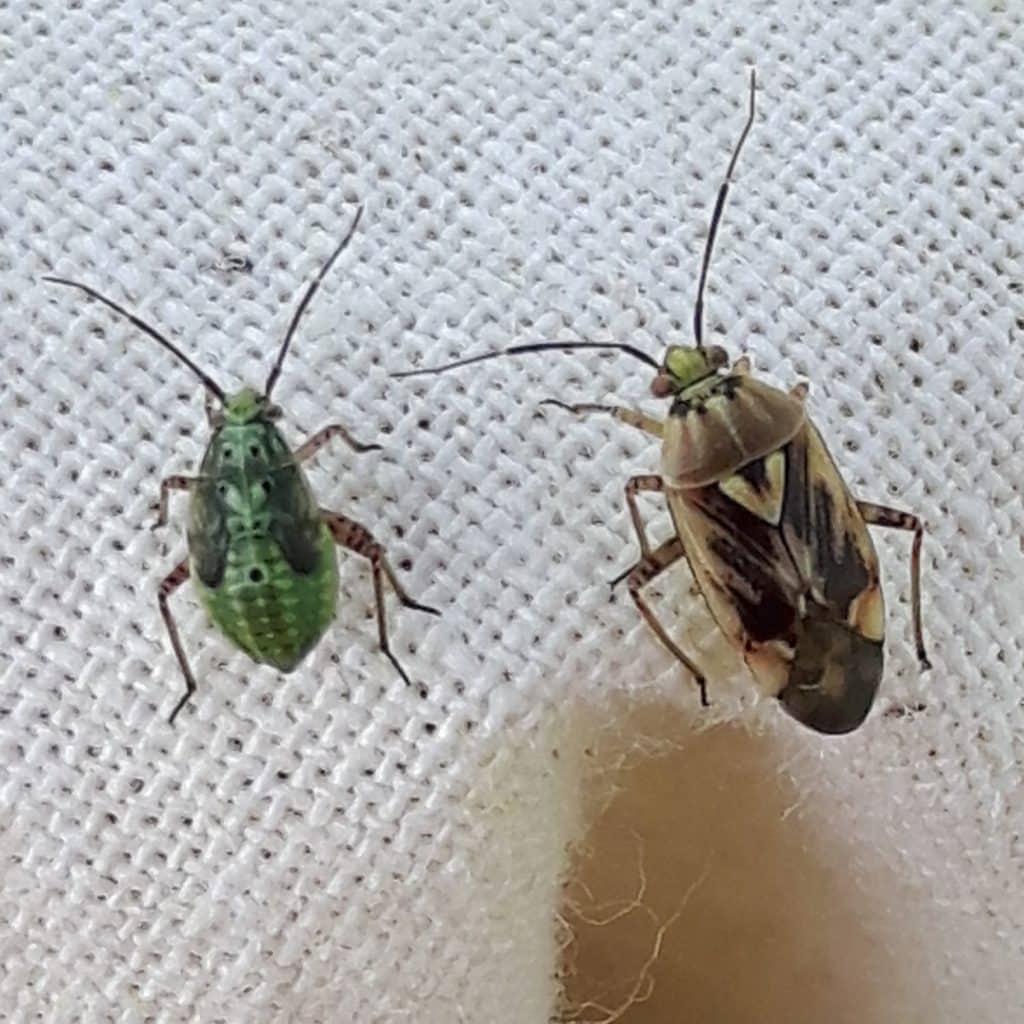
Adult lygus bugs are about three millimetres (0.1 inch) wide and six millimetres (0.2 inch) long. They have relatively long antennae and legs. They vary from pale green to reddish-brown to black and can range from a fairly uniform colour to a mottled appearance. Lygus bugs have a distinctive triangle or “V” shaped marking in the upper centre of their backs and membranous wing tips. Adults are active and fly readily when approached.
Ensure lygus bug adults are not confused with the bigger, longer alfalfa plant bug adults, which are similar in appearance (i.e. V- shape pattern on the back, green colour).
Lygus bug nymphs are light green and wingless. Young nymphs are often mistaken for aphids, which are similar in size and shape. However, lygus bug nymphs are much more active, are harder bodied and lack the cornicles (or “tail pipes”) of aphids. There are five instarA developmental stage within one life stage (ex. of an insect) More stages of lygus nymphs, of which the youngest are bright green and very mobile and the older ones are darker coloured. Nymphs feed on new growth and reproductive parts of the plant. Third instarA developmental stage within one life stage (ex. of an insect) More and older begin to develop wingpads (or wing buds) which are evident on the dorsal side of their bodies. Several black spots, usually five, become noticeable on the backs of nymphs as they moult or mature through instars before becoming adults.
Scouting techniques
Begin monitoring canola (for lygus bugs) from bolting through late podding stages (when seeds within the pods are firm). Collect samples in several locations in the field, including along or near the field margins. Taking more sweeps will provide a better assessment of pest populations. To collect an accurate sample, use a standard insect net of 38 centimetres (15 inches) in diameter, take ten 180° sweeps, and aim to sweep the buds, flowers and pods while moving forward. Count the number of lygus in the net. Scouting and sampling should be done under fair weather conditions (e.g. sunny, low wind, above 15 degrees Celsius) and typically between 10:00-16:00 to ensure lygus bugs are active within the canopy.
Use economic thresholds at the appropriate stage 10 which consider application costs and canola prices (as well as the canola development stage) to determine the need for a potential insecticide application or just continued scouting.
Identify and count third to fifth instarA developmental stage within one life stage (ex. of an insect) More lygus nymphs (which have black spots on their backs) when sweep net sampling at late flower and early pod stages of canola development. Third instarA developmental stage within one life stage (ex. of an insect) More or older nymphs and adults with black spots or developing wing ”shoulder” pads should be counted and compared to the economic thresholds at late flower stages because:
- Younger instars are more susceptible to rainfall and predation and may not reach adulthood. (However, keeping track of the population percentage below third instarA developmental stage within one life stage (ex. of an insect) More can be useful in prediction the impending third instarA developmental stage within one life stage (ex. of an insect) More population.)
- Third, fourth and fifth instarA developmental stage within one life stage (ex. of an insect) More nymphs experiencing warm growing conditions can develop quickly (moving through an instarA developmental stage within one life stage (ex. of an insect) More every two to three days).
- Both nymphs and adults are feed on (causing damage to) canola.
- Second, third, fourth and fifth instarA developmental stage within one life stage (ex. of an insect) More lygus nymphs on mid-flowering canola will contribute to adult lygus bug populations at (the vulnerable) early pod stages.
Damaging species
In western Canada, four Lygus species have been observed destroying canola flower buds and seeds, and all four species are thought to be equally destructive:
- L. keltoni Schwartz and Foottit
- L. lineolaris (Palisot de Beauvois) (also call the tarnished plant bug)
- L. elisus Van Duzee (also call the pale legume bug)
- L. borealis (Kelton)
The distribution and abundance of each species can vary by host plant, region, or even seasonally 6, 11 , 12,13. For example:
- In northern Alberta, L. keltoni and L. lineolaris species dominate.
- In southern Alberta, the L. elisus species dominated from 1999 to 2004, but L. keltoni and L. borealis were also present. However outbreaks in 2010 and 2011 were dominated by L. keltoni.
- L. lineolaris is very rare in the short grassland prairies of southern Alberta 6.
Type of crop damage
Adults and nymphs use a piercing-sucking mouthpart called a proboscis to feed on reproductive structures. All species of lygus bugs feed preferentially on buds, flowers, or developing seeds. Lygus are generalist herbivores attacking hundreds of plant species globally 13 .
Once a suitable plant structure is encountered, the proboscis is inserted into the tissue and various digestive enzymes are injected and then sucked back along with pre- digested plant nutrients 14.
Feeding on buds, flowers and young pods causes “blasting” (buds turn white and fail to develop), flowers fall without forming pods or pods drop without maturing 15,2,16,17.
Feeding punctures on the outside of pods and stems may ooze droplets of sap, causing an infested crop to become noticeably sticky. These droplets promote the entry of pathogens. Lygus feeding creates small, dark circular patches on the pod surface.
Feeding moves to other plants or younger tissue as canola seeds become firm, hard, and pod surfaces become difficult to pierce and feed upon.
Seeds that have been fed upon will collapse or shrink, darken and lose their quality and viability. Additional loss may occur if flowering is delayed by heavy feeding pressure or drought. In western Canada, lygus bugs typically damage up to seven per cent of the seed.
Adults and the oldest (fourth and fifth instarA developmental stage within one life stage (ex. of an insect) More) nymphs are responsible for most of the feeding injury.
One instance in southern Manitoba (prior to 1998), canola yields were reduced by approximately 20% when lygus bugs (mainly L. lineolaris) were confined on B. napusAlso referred to as Argentine canola, it is the species of canola currently commonly grown in Canada. More between flowering to pod maturity 18.
Management | How do you manage lygus bugs?
Natural enemies and biological control
Lygus bugs, like other insects, have a suite of natural enemies that in most years help to keep populations from reaching pest levels, such as parasitic wasps and predatory insects.
Parasitic wasps
A survey near Lethbridge in 2005-2006 found four species (Anaphes iole, a Telenomus species and two Polynema species) of parasitoid wasps (HymenopteraThe insect order (the scientific classification more broad than Family) which includes sawflies, wasps, bees, and ants. More: Mymaridae) that feed on lygus eggs 19. The average rate of lygus egg attack due to all of these parasitoids was nine per cent.
Some wasps also feed on lygus nymphs. Parasitoids of the genus Peristenus (HymenopteraThe insect order (the scientific classification more broad than Family) which includes sawflies, wasps, bees, and ants. More: Braconidae) caused 70 per cent nymphThe juvenile or immature stage (ex. of an insect) which goes through incomplete metamorphosis. More mortality at peak times in some alfalfa sites as reported for P. braunae near Saskatoon 20. In southern Alberta, the dominant wasp species attacking spring and early summer first generation lygus nymphs is P. carcamoi, whereas the second generation is attacked mainly by P. broadbenti 21. In northern Alberta, P. braunae and the more common P. otaniae attack the first and only generation of Lygus nymphs occurring in alfalfa and clover hay mixes 22. In addition, parasitism rates by Peristenus from rearings of third to fifth instarA developmental stage within one life stage (ex. of an insect) More lygus bugs ranged from 9.8 to 38.3 per cent in an alfalfa hay field in late June near Beaverlodge, Alberta.
Tachinid flies have also been reported to attack lygus bug adults in the Peace River region of Canada, although no specimens have been obtained to confirm the species 23.
Predatory insects
Laboratory studies showed ladybird beetles (Coccinella trifasciata, C. septempunctata) consumed low numbers of third, fourth and fifth instarA developmental stage within one life stage (ex. of an insect) More lygus bug nymphs whereas damselbugs (Nabis roseipennis, N. alternates), lacewing larvae (M. emuncta), and crab spiders (M. vatia) consumed greater numbers of lygus bug nymphs while also each demonstrating feeding preferences for different instarA developmental stage within one life stage (ex. of an insect) More staged nymphs. This suggests that these general predators all play a role in suppressing lygus bugs in canola within the canopy. They may also have feeding niches with each predator, collectively suppressing lygus bug populations but preferring specific instars as prey. Other lab results found lacewing larva consumes seven lygus bug nymphs every 24 hours.
Therefore, it is important to conserve and protect these natural enemies by using economic thresholds to determine the need for insecticidal control.
Biological control
A European wasp, Peristenus digoneutis, has been introduced into alfalfa fields in eastern North America where it parasitizes approximately 40 per cent of the tarnished plant bugs. One of the few parasitoids of lygus adults is a tachinid fly, Alophorella sp. Current research is in progress to evaluate the exotic P. digoneutis as a potential neoclassical biocontrol agent to assess the impact of this European species on lygus nymphs occurring in canola and to evaluate its impact on native communities of natural enemies.
Another potential biocontrol option is entomopathogenic nematodes (or EPNs). These predatory nematodes are soil-dwelling round worms that specialize in parasitizing insects, including lygus bugs. The Biocontrol potential of entomopathogenic nematodes (EPNs) against selected key insect pests of canola in Alberta project reported lygus bug nymphThe juvenile or immature stage (ex. of an insect) which goes through incomplete metamorphosis. More mortality rates of 39-87 per cent, depending on the concentrations of predatory nematodes that the lygus were subject to in the laboratory experiments.
Field management (cultural control)
Preseed and in-crop weed control and tillage reduces the availability of host weeds and volunteer canola host plants to early emerging overwintering adults and early hatching first generation nymphs. Control volunteer canola and other weed hosts that provide a food source or sites for egg laying. Weed hosts include flixweed, lamb’s quarters, wild mustard, stinkweed, redroot pigweed, kochia, Russian knapweed, and Russian thistle.
Lygus survivorship is lower in alfalfa compared to canola and they prefer to feed on canola compared to hairy, high glucosinolate mustard. Even so, lygus bug infestations still occur in mustard 20 and lygus bug populations in canola can exceed those in adjacent alfalfa fields, 24. There is an incorrect belief that lygus can reach pest status in canola after alfalfa hay is harvested nearby. However, a study over several site years in the parkland region (dominated by L. lineolaris in canola and L. borealis in alfalfa) including the three prairie provinces, found no such evidence, 24,13 though none of the sites experienced outbreak levels in the years of the study. Another study by Alberta Agriculture in 2014 -2016 found that the changes in Lygus spp. population numbers in neighbouring canola and alfalfa fields were largely independent of alfalfa harvest. The belief that lygus bugs move from alfalfa to canola following cutting of alfalfa is likely due to alfalfa harvest preceding natural population increases in canola fields rather than movement from alfalfa 25.
Resistance breeding
Hairy pods and relatively high concentrations of the glucosinolate sinalbin in Sinapis alba deterred L. lineolaris feeding, although these plant characteristics did not deter egg laying 26.
Economic threshold
Economic thresholds should be based on lygus bug sampling completed in canola at the end of flowering and early pod ripening stages. Once the pods have become tough or leathery and seeds are firm, lygus bugs can no longer penetrate the pods or seeds with their mouthparts and are no longer an economic threat. At this late crop stage, the cost of controlling lygus bugs may exceed the damage they will cause prior to harvest, so insecticide application is no longer warranted. Furthermore, the pre-harvest interval required after spraying may not allow for an application this late27.
Previous economic thresholds28 were conducted using previous plant stand recommendations (of seven to 14 plants per square foot) and were based on research with cultivarsCultivars are variants in a species developed through the intervention of humans (despite the term 'variety' often being incorrectly used to describe this). Cultivars can be open-pollinated type, hybrid, synthetic, composite, etc. More available in the late 1990s18. As new canola cultivarsCultivars are variants in a species developed through the intervention of humans (despite the term 'variety' often being incorrectly used to describe this). Cultivars can be open-pollinated type, hybrid, synthetic, composite, etc. More are developed and growers adopt different agronomic practices, plant tolerance to insect feeding damage and yield potential may also change.
Research completed from 2016 to 2019 29, which is supported by several entomologists across Western Canada 30 and the 2021 Oilseed Crops section of the Western Committee on Crop Pests Guide to Integrated Control of Insect Pests of Crops 31, reports that a range of 2-3 lygus per sweep (or 20-30 lygus per 10 sweeps). This recommendation is more suitable for current practices and canola cultivarsCultivars are variants in a species developed through the intervention of humans (despite the term 'variety' often being incorrectly used to describe this). Cultivars can be open-pollinated type, hybrid, synthetic, composite, etc. More, which appear to tolerate lygus damage better than older cultivarsCultivars are variants in a species developed through the intervention of humans (despite the term 'variety' often being incorrectly used to describe this). Cultivars can be open-pollinated type, hybrid, synthetic, composite, etc. More. Risk-averse growers can take action at the lower range (two lygus per sweep or 20 lygus per 10 sweeps), while those willing to take on more risk and increase protection of natural enemies by spraying in fewer instances, can take action when lygus are over three per sweep or 30 lygus per 10 sweeps. Using the lower end of the threshold (about 20 lygus per 10 sweeps) may be appropriate for stressed canola with less ability to compensate for feeding 27.
Reducing the threshold because of increasing prices is not recommended for lygus (or most insect pests) because there is not a strong linear relationship between yield and pest abundance. In fact, less than one lygus per sweep may actually stimulate yield. Also, when there is more than 100 millimetres of precipitation from the onset of bud formation to the end of flowering, the crop may partially compensate for plant bug damage. 27.
To maximize accuracy of sampling results when considering economic thresholds, make 10 sweeps with a 38 cm diameter insect net at each sampling site. If populations appear to be of concern, take additional samples; a minimum of 15 samples is needed to accurately determine whether controls are economical. If possible, sample canola on a sunny day when the temperature is above 20°C and the crop canopy is dry 27. More tips on proper sweep net sampling technique are available in this Canola Watch article.
Additional information and tips for growers and agronomists on lygus scouting, thresholds and timing in canola is available in this Canola Watch fundamentals article.
Research (from the ‘Does canola compensate for lygus bug damage?‘ project) reported that usually one application of a registered insecticide at the end of flowering (bloom 90% complete or more) or at pod formation will prevent most yield losses 32. Plot research has shown that insecticide applications applied at flowering stage do not control later emerging nymphs.
The exception to this is in the Peace River region where early, dry springs and unusually high densities of lygus bug adults can occasionally occur at bud stage. In this situation, high numbers of lygus bugs feeding on moisture-stressed canola at bud stage is suspected to result in a delay of flowering, so producers in that region should monitor in fields that fail to flower.
If soil moisture levels and rainfall are high at flowering, plants will likely be able to compensate for damage caused by lygus bug populations near or above economic thresholds, and control may not be necessary. Since plants under moisture stress during this plant development stage will usually be unable to compensate for most of the feeding injury, control may be required using economic thresholds.
In southern Alberta and Saskatchewan, lygus bug often co-occurs with the cabbage seedpod weevil, which attacks canola at the early flower stage, but each insect should be considered separately. A four-year study (ending in 2014) assessing the impact of cabbage seedpod weevil control on lygus bugs found that spraying for weevils at the early flower stage (earlier than the optimum stage for lygus bug feeding), reduced lygus bug abundance at most of the sites, but yield responses were inconsistent. Therefore, scouting for and management of cabbage seedpod weevil and lygus bug should be considered separately 33.
Chemical control
Once populations have reached economic thresholdAn economic threshold is the level of infestation (ex. pest insect density) at which lost yield (ex. due to feeding/insect pest damage) exceeds the cost of the chemical and its application. More levels, insecticide application is the only option for control of lygus bugs.
Based on the Management of lygus bugs and seedpod weevil in canola at the farm level research, it is important to make decisions based on thorough field monitoring rather than practices applied on neighbouring fields or reported local and regional weather conditions. It is also recommended to sweep for lygus bugs after a heavy rainfall before making a spraying decision. However, tank mixing insecticide with fungicide spray in full flower is not recommended for control of lygus bugs (or cabbage seedpod weevil) and can be harmful to pollinators and natural enemies.
To reduce direct exposure to pollinators, apply insecticides very late in the evening or early morning when bees are not foraging and the crop has completed at least 90 per cent bloom. When treating for lygus, prevent spay drift from moving onto beehives, blooming weeds or surrounding fields. Notify beekeepers of your intention to treat the field 48 hours in advance of spraying. Try to select an insecticide that has a short residual activity to reduce the impact on pollinators.
Product options
Insecticide products registered with the Pest Management Regulatory Agency and current recommendations are available in the annual provincial crop protection guides and always refer to product labels.
- Alberta Crop Protection Guide (The Blue Book)
- Saskatchewan Guide to Crop Protection
- Manitoba Guide to Field Crop Protection
The Western Committee on Crop Pests provides guidelines for the control of insect pests in oilseed crops in Western Canada 34.
Insecticides registered for Lygus species in canola
1 LD50 values represent the relative toxicity of a pesticide. They represent the dose (in mg/kg body weight) that will kill 50% of the test animals. Thus the lower the number the greater the toxicity. Values given are for oral female rat LD50.
*Talk to your grain buyer prior to application.
Note: Always check your provincial crop protection guide for current listings of registered control products, and always read and follow current pesticide label directions.
Source: Alberta Crop protection Guide 2022 and Alberta Crop protection Guide 2023 (The Blue Book)
Footnotes
- Butts, R.A., and Lamb, R.J. 1990. Injury to oilseed rape caused by mirid bugs (Lygus) (Heteroptera: Miridae) and its effect on seed production. Ann. Appl. Biol. 117: 253-266.[↩]
- Butts, R.A., and Lamb, R.J. 1991. Pest status of lygus bugs (Hemiptera: Miridae) in oilseed Brassica crops. J. Econ. Entomol. 84, 1591-1596.[↩][↩]
- Gerber, G.H., and I.L. Wise. 1995. Seasonal occurrence and number of generations of Lygus lineolaris and L. borealis (Heteroptera: Miridae) in southern Manitoba. Can. Entomol. 127: 543-559.[↩]
- Turnock, W.J., G.H. Gerber, B.H. Timlick, and R.J. Lamb. 1995. Losses of canola seeds from feeding by Lygus species (Heteroptera: Miridae) in Manitoba Can. J. Pl. Sci. 75:731-736.[↩]
- Héctor Cárcamo, insect pest management research scientist, Agriculture and Agri-Food CanadaAgriculture and Agri-Food Canada is a department of the Government of Canada. More Lethbridge and Scott Meers, (retired) insect management specialist with Alberta Agriculture and Forestry. Personal communication, July 2021.[↩]
- Cárcamo, H., Otani, J., Herle, C., Dolinski, M., Dosdall, L., Mason, P., Butts, R., Kaminski, L., Olfert, O. 2002. Variation of Lygus species assemblages in canola agroecosystems in relation to ecoregion and crop stage. The Canadian Entomologist. 134(1): 97-111. doi:10.4039/Ent13497-1.[↩][↩][↩]
- Wise, I.L., Elliott, B.G. and Mostafa, A.M. 2005. Seasonal occurrence and within-field distribution of Lygus lineolaris on buckwheat in Manitoba. Can. Entomol. 137, 598-601.[↩][↩][↩]
- Cárcamo, H.A. and Otani, J. 2005. Impacts of lygus plant bugs on canola in western Canada. Proceedings of International Symposium – Ecology and Management of Lygus plant bugs, Ottawa, Ontario, January 30-February 3, 2005. 21.[↩]
- Cárcamo and Herle unpublished data[↩]
- Wise, I.L. and Lamb, R.J. 1998. Sampling plant bugs, Lygus spp. (Heteroptera: Miridae), in canola to make control decisions. Can. Entomol. 130(6), 837-851.[↩][↩]
- Kelton, L.A. 1975. The Lygus bugs (Genus Lygus Hahn) of North America (Heteroptera: Miridae). Memoirs of the Entomological Society of Canada. 95.[↩]
- Timlick, B.H., Turnock, W.J. and Wise, I. 1993. Distribution and abundance of Lygus spp. (Heteroptera: Miridae) on alfalfa and canola in Manitoba. Can. Entomol. 125: 1033-1041.[↩]
- Young, O.P. 1986. Host plants of the tarnished plant bug, Lygus lineolaris (Heteroptera: Miridae). Ann. Entomol. Soc. Amer. 79, 747-762.[↩][↩][↩]
- Hori, K. 1976. Physiological changes in host and insect. Lygus bug: Host plant interactions. University Press of Idaho. 38.[↩]
- Butts, R.A., and Lamb, R.J. 1990. Injury to oilseed rape caused by mirid bugs (Lygus) (Heteroptera: Miridae) and its effect on seed production. Ann. Appl. Biol. 117:253-266.[↩]
- Turnock, W.J., Gerber, G.H., Timlick, B.H. and Lamb, R.J. 1995. Losses of canola seeds from feeding by Lygus species (Heteroptera: Miridae) in Manitoba Can. J. Pl. Sci. 75:731-736.[↩]
- Butts, R. A. and Lamb, R.J. 1991. Seasonal abundance of three Lygus species (Heteroptera:Miridae) in oilseed rape and alfalfa in Alberta. J. Econ. Entomol. 84: 450-456.[↩]
- Wise, I.L. and Lamb, R.J. 1998. Economic thresholdAn economic threshold is the level of infestation (ex. pest insect density) at which lost yield (ex. due to feeding/insect pest damage) exceeds the cost of the chemical and its application. More for plant bugs, Lygus spp. (Heteroptera: Miridae), in canola. Can. Entomol. 130, 825-836. doi:10.4039/Ent130825-6[↩][↩]
- Cárcamo, H., Huber, J. Larson, T. and Bourchier, R. 2007. Egg parasitoids of lygus bugs in southern Alberta. Proceedings of the 2nd International Lygus bug symposium, Asilomar California, April 19, 2007. J. Ins. Sci. Available online at: www.insectscience.org/8.49/ref/abstract11.html[↩]
- Braun, L., Erlandson, M., Baldwin, D., Soroka, J., Mason, P., Foottit, R., and Hegedus, D. 2001. Seasonal occurrence, species composition, and parasitism of Lygus spp in alfalfa, canola, and mustard. Can. Entomol. 133: 565-577.[↩][↩]
- Goulet, H., and Mason, P.G. 2006. Review of the nearctic species of Leiophron and Peristenus (HymenopteraThe insect order (the scientific classification more broad than Family) which includes sawflies, wasps, bees, and ants. More: Braconidae: Euphorinae) parasitizing Lygus (Hemiptera: Miridae: Mirini). Zootaxa. 1323: 1-118.[↩]
- Goulet, H., and Mason, P.G. 2006. Review of the nearctic species of Leiophron and Peristenus (HymenopteraThe insect order (the scientific classification more broad than Family) which includes sawflies, wasps, bees, and ants. More: Braconidae: Euphorinae) parasitizing Lygus (Hemiptera: Miridae: Mirini). Zootaxa. 1323: 1-118.[↩]
- Otani, J. Unpublished data[↩]
- Cárcamo, H.A., Otani, J., Gavloski, J., Dolinski, M. and Soroka, J. 2003. Abundance of Lygus spp. (Heteroptera: Miridae) in canola adjacent to forage and seed alfalfa. J. Entomol. Soc. B. C. 100:55-63.[↩][↩]
- Sim, K. and Meers, S. 2017. Alfalfa Insect Survey (2014F) 62R. Alberta Agriculture and Forestry, Brooks, Alberta[↩]
- Bodnaryk, R.P. 1996. Physical and chemical defenses of pods and seeds of white mustard (Sinapis alba L.) against tarnished plant bugs, Lygus lineolaris (Palisot de Beauvois)(Heteroptera: Miridae). Can. J. Plant Sci. 76: 33-36.[↩]
- Manitoba Agriculture. 2022. Guide to Field Crop Protection. Insect Control section. Available online.[↩][↩][↩][↩]
- Western Committee on Crop Pests Guide to Integrated Control of Insect Pests of Crops. 2020. Insect management in oilseed crops in Western Canada. Retrieved from: https://westernforum.org/Documents/WCCP/WCCP_documents/WCCP_Guidelines/WCCP_19/Oilseeds%20WCCP%202019b.pdf[↩]
- Cárcamo, H. 2016. Validation of lygus and other insect pest thresholds in commercial farms throughout Alberta. Canola Agronomic Research Program (CARP 2016.27).[↩]
- John Gavloski, entomologist, Manitoba Agriculture and Resource Development; Hector Cárcamo, insect pest management research scientist, Agriculture and Agri-Food CanadaAgriculture and Agri-Food Canada is a department of the Government of Canada. More Lethbridge, Scott Meers, (retired) insect management specialist with Alberta Agriculture and Forestry and Meghan Vankosky, field crop entomology research scientist with Agriculture and Agri-Food CanadaAgriculture and Agri-Food Canada is a department of the Government of Canada. More Saskatoon. Personal communication, July 2021.[↩]
- Western Committee on Crop Pests Guide to Integrated Control of Insect Pests of Crops. 2021. Insect management in oilseed crops in Western Canada. Retrieved from: https://westernforum.org/Documents/WCCP/WCCP_documents/WCCP_Guidelines/WCCP_20/Oilseeds-WCCP-2021-Final.pdf[↩]
- Jones, J.W., Cárcamo, H.A., Otani, J.K., Butts, R.A., McKenzie, R.H., Solberg, E.D. and DeMulder, J. 2003. Does canola compensate for lygus bug damage? Final Report 1999M462. Canola Council of Canada and Alberta Agricultural Research Institute, Edmonton, Alberta, Canada.[↩]
- Cárcamo, H. 2014. Management of lygus bugs and seedpod weevil in canola at the farm level. Canola Agronomic Research Program.[↩]
- Western Committee on Crop Pests. 2021. Guide to Integrated Control of Insect Pests of Crops: Insect Management in Oilseed Crops in Western Canada. 2021. Retrieved from: https://westernforum.org/Documents/WCCP/WCCP_documents/WCCP_Guidelines/WCCP_20/Oilseeds-WCCP-2021-Final.pdf[↩]
